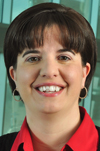You rush up to a building, and it’s so cold out that you hit that magical door opening button, also known as an Americans with Disabilities Act (ADA) button, so you don’t have to touch the handle. The door swings open for you and you scamper inside.
|
LIVEGREEN |
by Melanie Stewart |
You’ve done a good deed, right? You kept your hands cleaner, used a button that is meant to be used, and in the case of the Durham Outpatient Center and Clarkson Tower, didn’t use the big revolving door to sweep cold air into the building.
Those are all good thoughts — but unfortunately, wrong.
ADA buttons are designed to be used by people who cannot hold the door open for themselves while safely getting through the doorway. They also can be used in areas where large items, generally carts or beds, will be taken through and the door needs to be held open.
So, let’s dispel some myths:
ADA doors are still designed to be used manually. Even if you can hear the gears moving, you are not damaging them. If you are still concerned, use the door on the other side.
Our EVS staff cleans door handles and ADA buttons regularly as part of infection control. However, the area you touch on a door is larger and you are more likely to touch a different area there, than you would on an ADA button. So the button’s not necessarily dirtier, but definitely not any cleaner.
ADA doors are often used by individuals who believe they need to use them, and doors stay open much longer than they would otherwise, letting in a lot of cold (or hot) air. In addition to making people in the adjacent areas uncomfortable, we use a lot of energy to counter that change in temperature.
In the case of the Durham Outpatient Center or Clarkson Tower revolving doors, they actually help maintain pressure in the building and do not bring in a lot of outside air. The ADA door stays open and allows air to be sucked right into the building, making the lobby and atrium cold (or hot) until the climate-control system can catch up.
Who knew such a little action could have such a big impact? Think before you hit the button next time, and only use it if you need to. You’ll save energy and make spaces more comfortable for employees and visitors. Plus, you don’t turn out like this guy!


Love the video! This is a good reminder.
Thank you for writing this article. Patients waiting on cabs, rides, etc freeze to death in the entry area due to the negligence of those who walk out the ADA door hitting the button as they are leaving. This makes no sense to me.
Melanie,
Thanks!! I appreciate you publishing this article after listening to my input on educating the campus to open the door instead of pushing the ADA button. People using the ADA button between Poynter Hall and Wittson Hall impact the temperature of the labs and offices near the doors.
I hope this article is effective in educating the campus about conserving energy and think about how stopping an 'old' habit can make a big difference!
I second all the comments listed below! Thank you for this article! I hate seeing patients waiting near the front of Durham Outpatient Center miserable and freezing because that automatic door just stays open pretty much the whole time. I don't know why people are so opposed to using the revolving door, but it's a bummer!